Organizational Learning in Australia: Barriers and Recommendations
VerifiedAdded on 2022/09/30
|10
|1871
|23
Report
AI Summary
This report provides an overview of organizational learning, focusing on the Australian context. It identifies five key barriers to organizational learning, including resistance to change, lack of leadership training, disregard for team success, lack of motivation for growth, and a short-term focus. The report then proposes four strategies to overcome these barriers: personalized content, continuous commitment to content, bite-sized learning, and social learning. The conclusion emphasizes the importance of a culture of organizational learning that fosters knowledge, capability, and performance improvements, ultimately contributing to the achievement of business goals, innovation, and adaptability. The report references various academic sources to support its findings and recommendations.
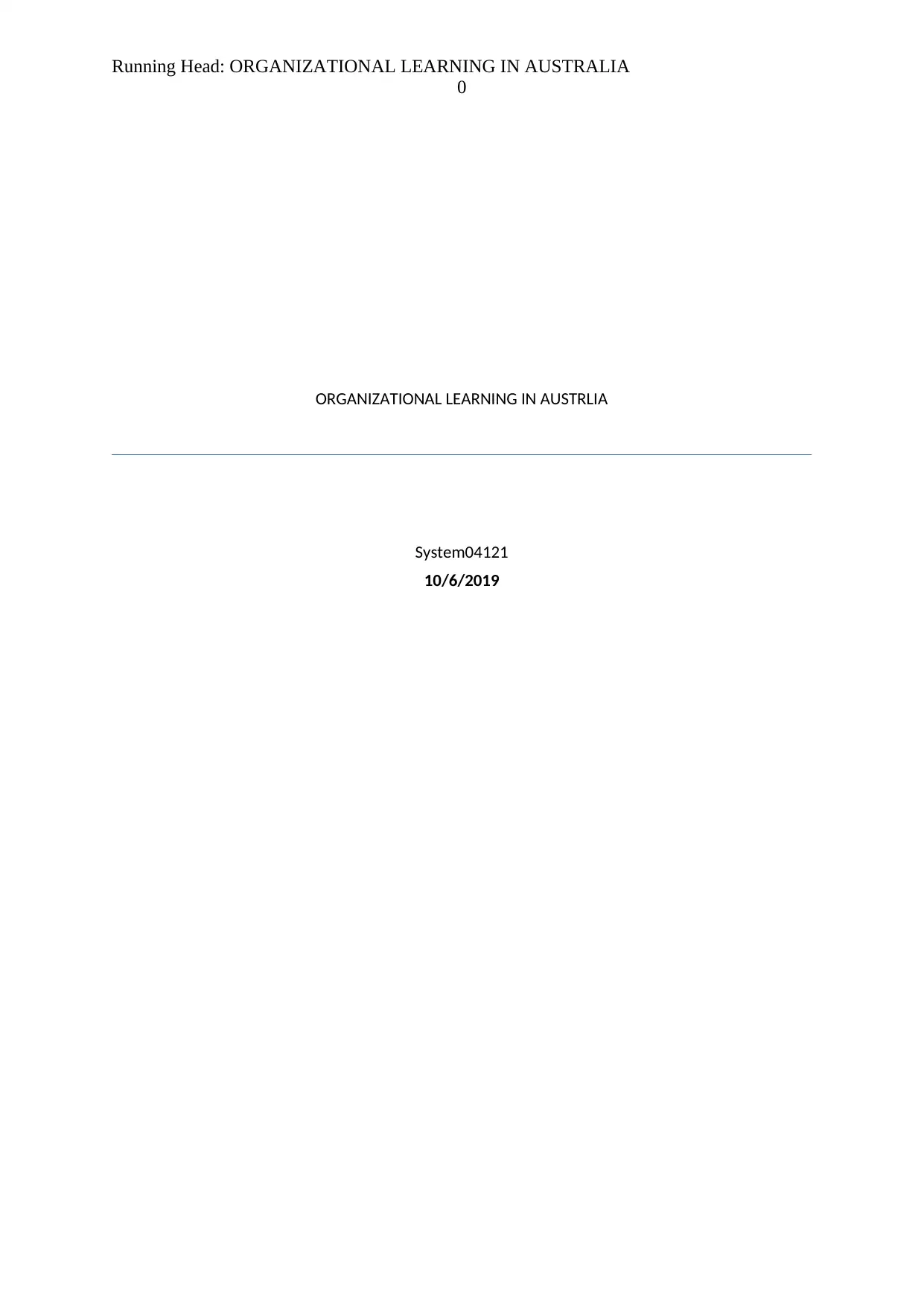
Running Head: ORGANIZATIONAL LEARNING IN AUSTRALIA
0
ORGANIZATIONAL LEARNING IN AUSTRLIA
System04121
10/6/2019
0
ORGANIZATIONAL LEARNING IN AUSTRLIA
System04121
10/6/2019
Paraphrase This Document
Need a fresh take? Get an instant paraphrase of this document with our AI Paraphraser
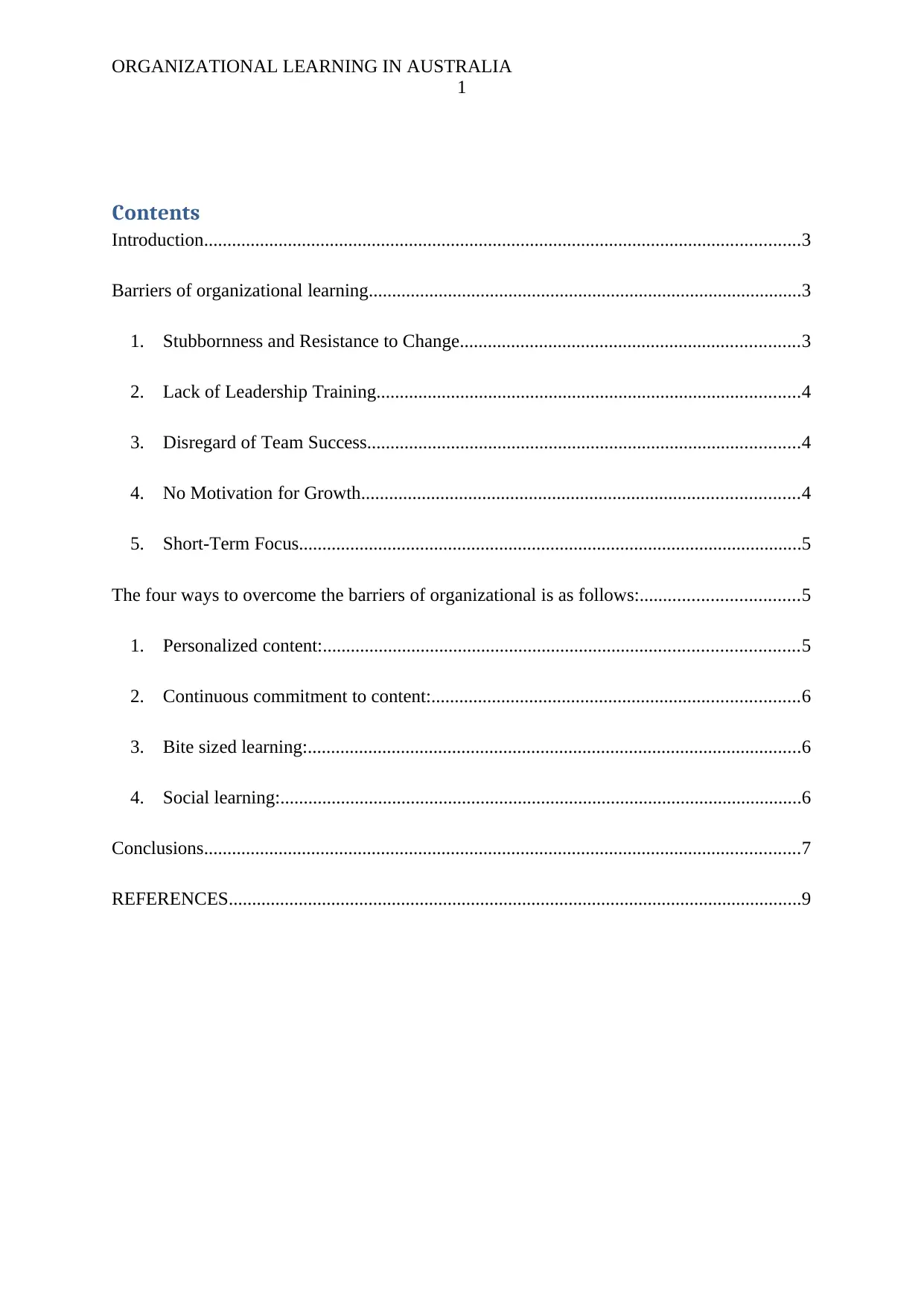
ORGANIZATIONAL LEARNING IN AUSTRALIA
1
Contents
Introduction................................................................................................................................3
Barriers of organizational learning.............................................................................................3
1. Stubbornness and Resistance to Change.........................................................................3
2. Lack of Leadership Training...........................................................................................4
3. Disregard of Team Success.............................................................................................4
4. No Motivation for Growth..............................................................................................4
5. Short-Term Focus............................................................................................................5
The four ways to overcome the barriers of organizational is as follows:..................................5
1. Personalized content:......................................................................................................5
2. Continuous commitment to content:...............................................................................6
3. Bite sized learning:..........................................................................................................6
4. Social learning:................................................................................................................6
Conclusions................................................................................................................................7
REFERENCES...........................................................................................................................9
1
Contents
Introduction................................................................................................................................3
Barriers of organizational learning.............................................................................................3
1. Stubbornness and Resistance to Change.........................................................................3
2. Lack of Leadership Training...........................................................................................4
3. Disregard of Team Success.............................................................................................4
4. No Motivation for Growth..............................................................................................4
5. Short-Term Focus............................................................................................................5
The four ways to overcome the barriers of organizational is as follows:..................................5
1. Personalized content:......................................................................................................5
2. Continuous commitment to content:...............................................................................6
3. Bite sized learning:..........................................................................................................6
4. Social learning:................................................................................................................6
Conclusions................................................................................................................................7
REFERENCES...........................................................................................................................9
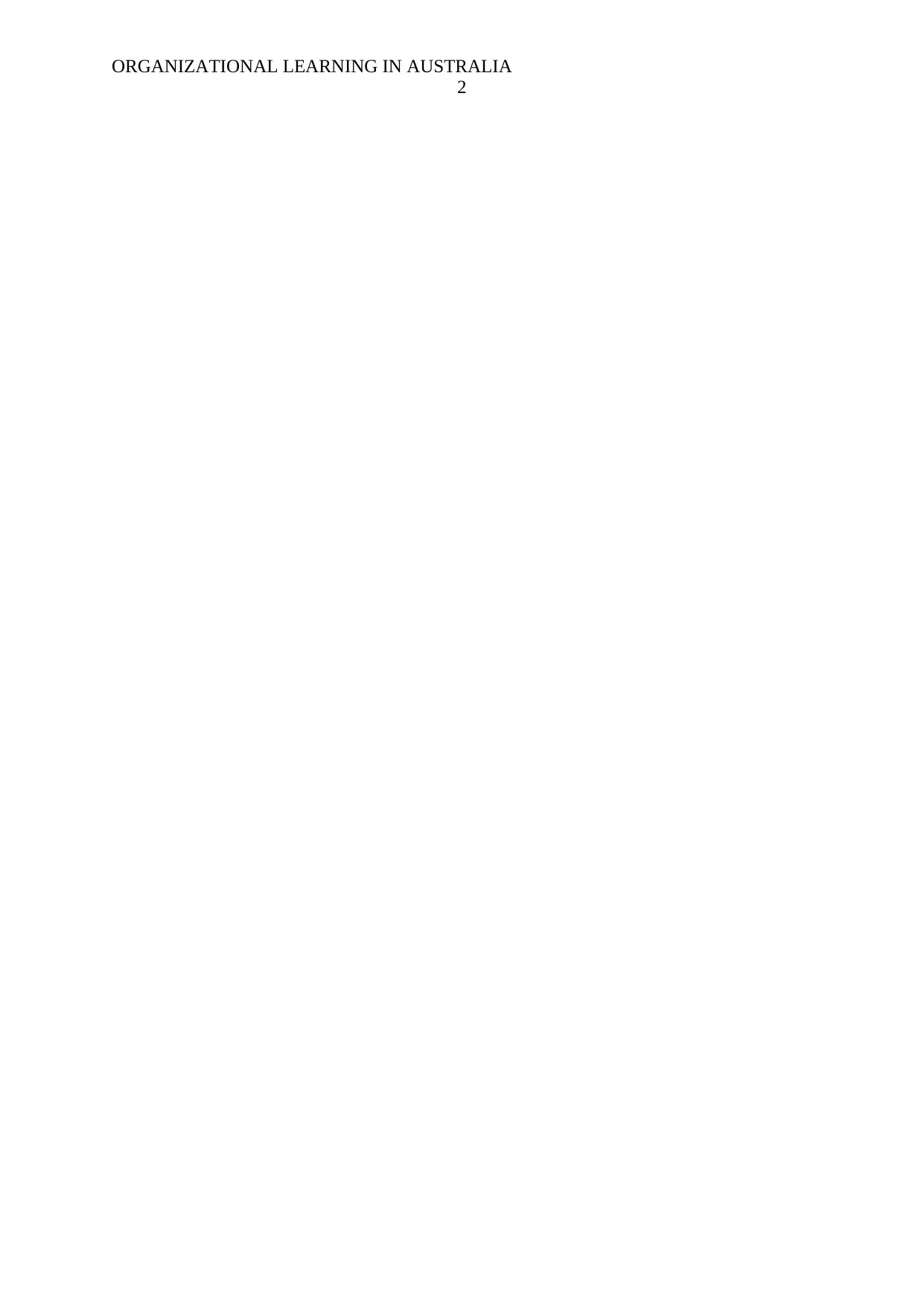
ORGANIZATIONAL LEARNING IN AUSTRALIA
2
2
⊘ This is a preview!⊘
Do you want full access?
Subscribe today to unlock all pages.

Trusted by 1+ million students worldwide
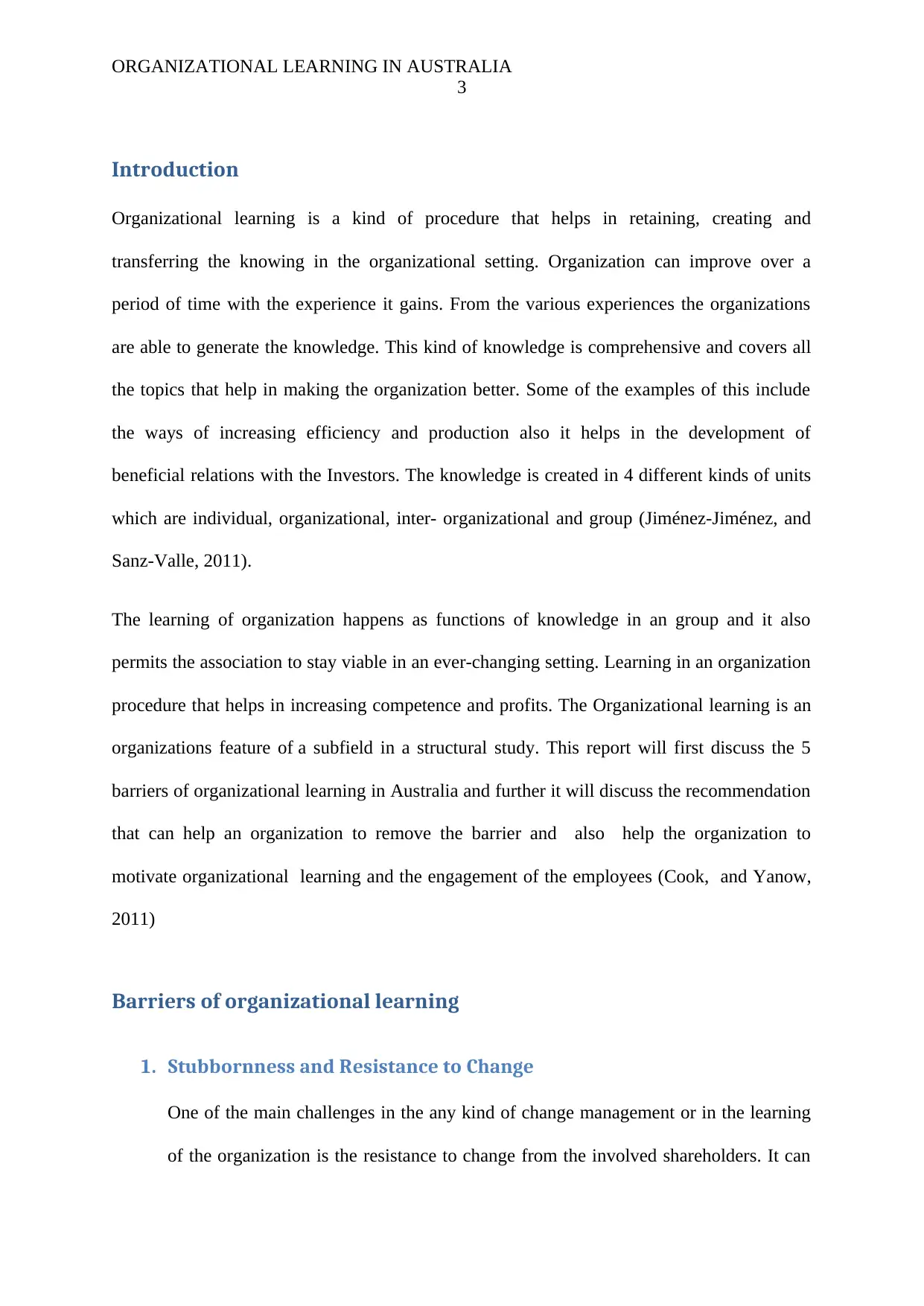
ORGANIZATIONAL LEARNING IN AUSTRALIA
3
Introduction
Organizational learning is a kind of procedure that helps in retaining, creating and
transferring the knowing in the organizational setting. Organization can improve over a
period of time with the experience it gains. From the various experiences the organizations
are able to generate the knowledge. This kind of knowledge is comprehensive and covers all
the topics that help in making the organization better. Some of the examples of this include
the ways of increasing efficiency and production also it helps in the development of
beneficial relations with the Investors. The knowledge is created in 4 different kinds of units
which are individual, organizational, inter- organizational and group (Jiménez-Jiménez, and
Sanz-Valle, 2011).
The learning of organization happens as functions of knowledge in an group and it also
permits the association to stay viable in an ever-changing setting. Learning in an organization
procedure that helps in increasing competence and profits. The Organizational learning is an
organizations feature of a subfield in a structural study. This report will first discuss the 5
barriers of organizational learning in Australia and further it will discuss the recommendation
that can help an organization to remove the barrier and also help the organization to
motivate organizational learning and the engagement of the employees (Cook, and Yanow,
2011)
Barriers of organizational learning
1. Stubbornness and Resistance to Change
One of the main challenges in the any kind of change management or in the learning
of the organization is the resistance to change from the involved shareholders. It can
3
Introduction
Organizational learning is a kind of procedure that helps in retaining, creating and
transferring the knowing in the organizational setting. Organization can improve over a
period of time with the experience it gains. From the various experiences the organizations
are able to generate the knowledge. This kind of knowledge is comprehensive and covers all
the topics that help in making the organization better. Some of the examples of this include
the ways of increasing efficiency and production also it helps in the development of
beneficial relations with the Investors. The knowledge is created in 4 different kinds of units
which are individual, organizational, inter- organizational and group (Jiménez-Jiménez, and
Sanz-Valle, 2011).
The learning of organization happens as functions of knowledge in an group and it also
permits the association to stay viable in an ever-changing setting. Learning in an organization
procedure that helps in increasing competence and profits. The Organizational learning is an
organizations feature of a subfield in a structural study. This report will first discuss the 5
barriers of organizational learning in Australia and further it will discuss the recommendation
that can help an organization to remove the barrier and also help the organization to
motivate organizational learning and the engagement of the employees (Cook, and Yanow,
2011)
Barriers of organizational learning
1. Stubbornness and Resistance to Change
One of the main challenges in the any kind of change management or in the learning
of the organization is the resistance to change from the involved shareholders. It can
Paraphrase This Document
Need a fresh take? Get an instant paraphrase of this document with our AI Paraphraser
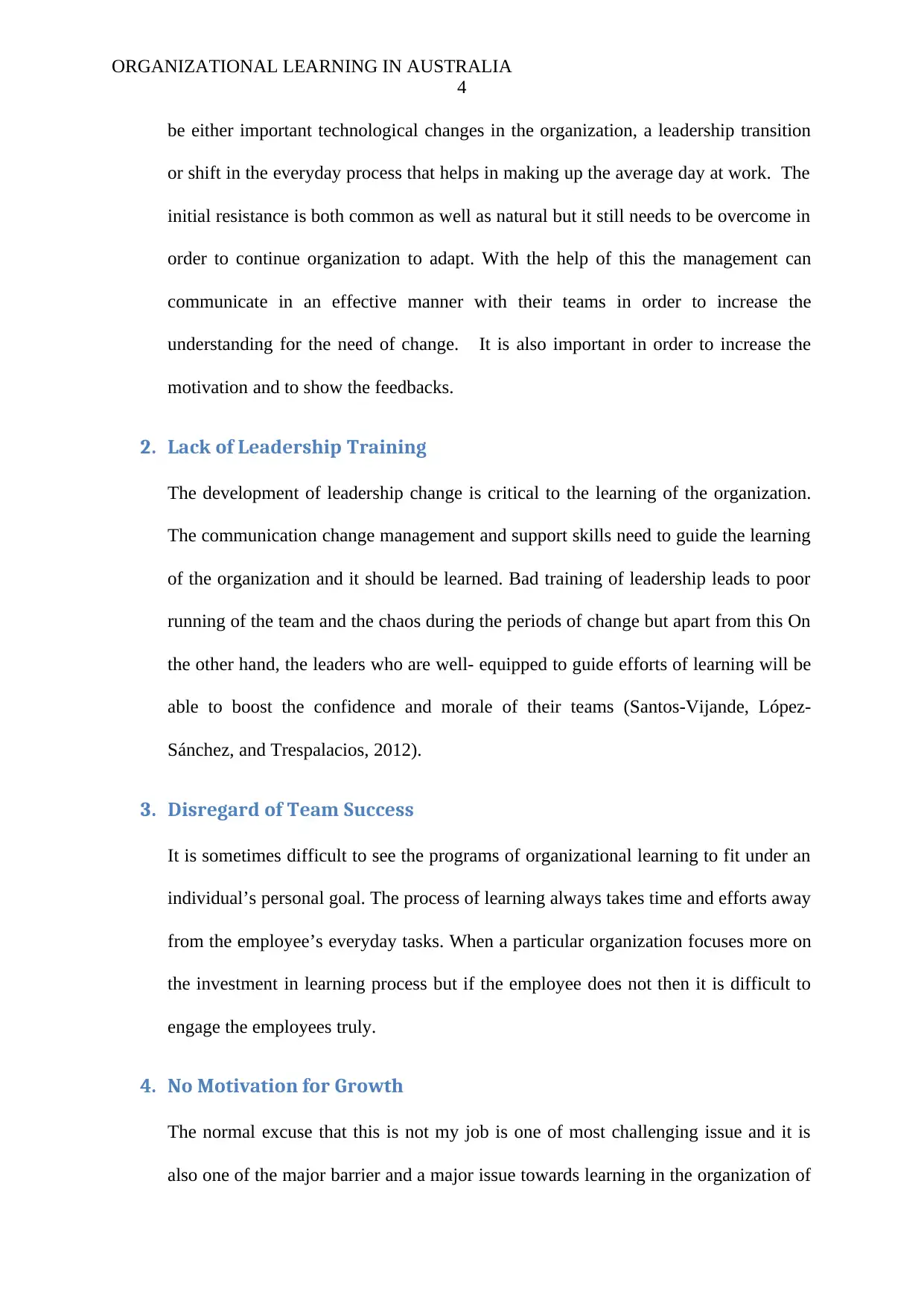
ORGANIZATIONAL LEARNING IN AUSTRALIA
4
be either important technological changes in the organization, a leadership transition
or shift in the everyday process that helps in making up the average day at work. The
initial resistance is both common as well as natural but it still needs to be overcome in
order to continue organization to adapt. With the help of this the management can
communicate in an effective manner with their teams in order to increase the
understanding for the need of change. It is also important in order to increase the
motivation and to show the feedbacks.
2. Lack of Leadership Training
The development of leadership change is critical to the learning of the organization.
The communication change management and support skills need to guide the learning
of the organization and it should be learned. Bad training of leadership leads to poor
running of the team and the chaos during the periods of change but apart from this On
the other hand, the leaders who are well- equipped to guide efforts of learning will be
able to boost the confidence and morale of their teams (Santos-Vijande, López-
Sánchez, and Trespalacios, 2012).
3. Disregard of Team Success
It is sometimes difficult to see the programs of organizational learning to fit under an
individual’s personal goal. The process of learning always takes time and efforts away
from the employee’s everyday tasks. When a particular organization focuses more on
the investment in learning process but if the employee does not then it is difficult to
engage the employees truly.
4. No Motivation for Growth
The normal excuse that this is not my job is one of most challenging issue and it is
also one of the major barrier and a major issue towards learning in the organization of
4
be either important technological changes in the organization, a leadership transition
or shift in the everyday process that helps in making up the average day at work. The
initial resistance is both common as well as natural but it still needs to be overcome in
order to continue organization to adapt. With the help of this the management can
communicate in an effective manner with their teams in order to increase the
understanding for the need of change. It is also important in order to increase the
motivation and to show the feedbacks.
2. Lack of Leadership Training
The development of leadership change is critical to the learning of the organization.
The communication change management and support skills need to guide the learning
of the organization and it should be learned. Bad training of leadership leads to poor
running of the team and the chaos during the periods of change but apart from this On
the other hand, the leaders who are well- equipped to guide efforts of learning will be
able to boost the confidence and morale of their teams (Santos-Vijande, López-
Sánchez, and Trespalacios, 2012).
3. Disregard of Team Success
It is sometimes difficult to see the programs of organizational learning to fit under an
individual’s personal goal. The process of learning always takes time and efforts away
from the employee’s everyday tasks. When a particular organization focuses more on
the investment in learning process but if the employee does not then it is difficult to
engage the employees truly.
4. No Motivation for Growth
The normal excuse that this is not my job is one of most challenging issue and it is
also one of the major barrier and a major issue towards learning in the organization of
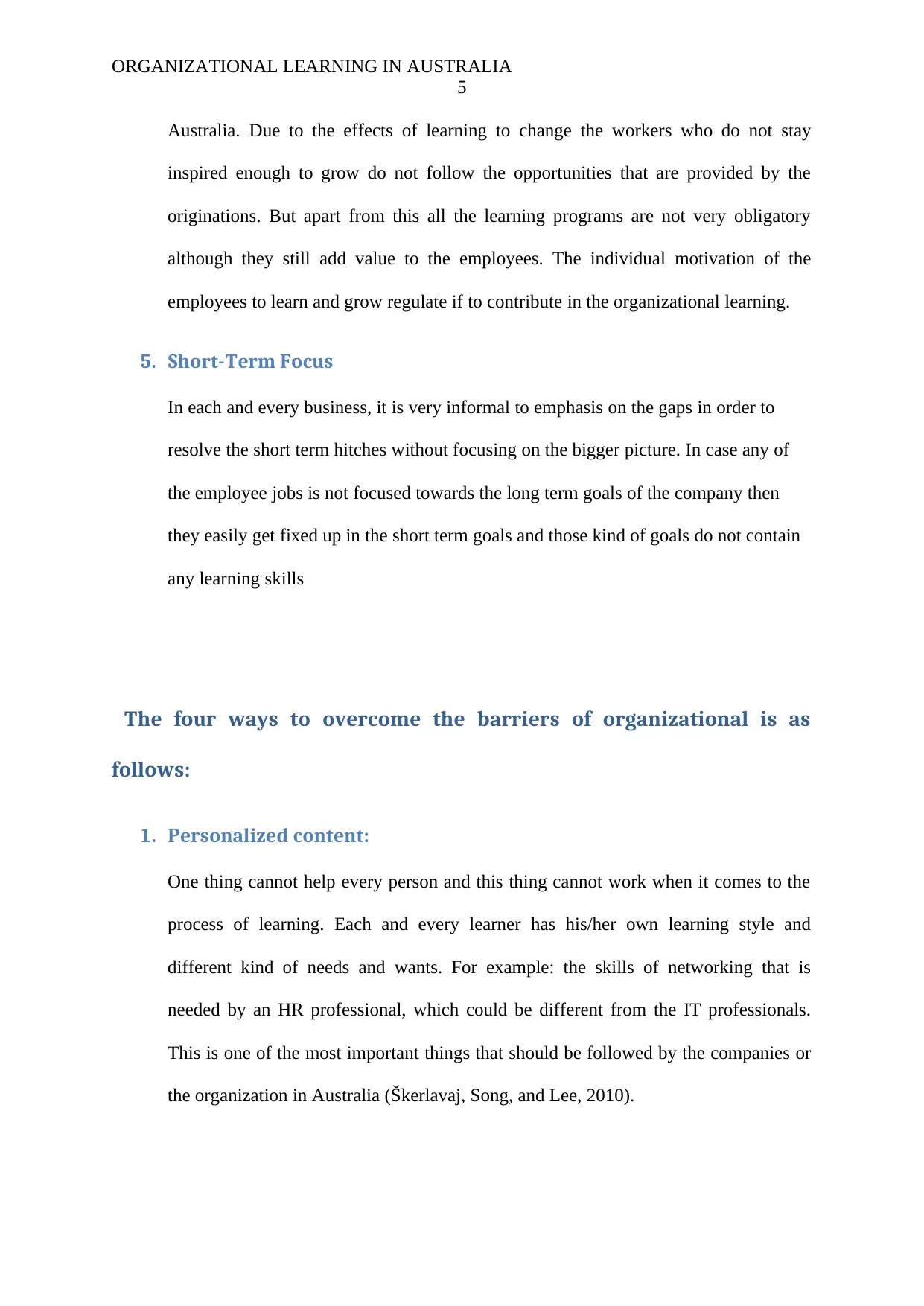
ORGANIZATIONAL LEARNING IN AUSTRALIA
5
Australia. Due to the effects of learning to change the workers who do not stay
inspired enough to grow do not follow the opportunities that are provided by the
originations. But apart from this all the learning programs are not very obligatory
although they still add value to the employees. The individual motivation of the
employees to learn and grow regulate if to contribute in the organizational learning.
5. Short-Term Focus
In each and every business, it is very informal to emphasis on the gaps in order to
resolve the short term hitches without focusing on the bigger picture. In case any of
the employee jobs is not focused towards the long term goals of the company then
they easily get fixed up in the short term goals and those kind of goals do not contain
any learning skills
The four ways to overcome the barriers of organizational is as
follows:
1. Personalized content:
One thing cannot help every person and this thing cannot work when it comes to the
process of learning. Each and every learner has his/her own learning style and
different kind of needs and wants. For example: the skills of networking that is
needed by an HR professional, which could be different from the IT professionals.
This is one of the most important things that should be followed by the companies or
the organization in Australia (Škerlavaj, Song, and Lee, 2010).
5
Australia. Due to the effects of learning to change the workers who do not stay
inspired enough to grow do not follow the opportunities that are provided by the
originations. But apart from this all the learning programs are not very obligatory
although they still add value to the employees. The individual motivation of the
employees to learn and grow regulate if to contribute in the organizational learning.
5. Short-Term Focus
In each and every business, it is very informal to emphasis on the gaps in order to
resolve the short term hitches without focusing on the bigger picture. In case any of
the employee jobs is not focused towards the long term goals of the company then
they easily get fixed up in the short term goals and those kind of goals do not contain
any learning skills
The four ways to overcome the barriers of organizational is as
follows:
1. Personalized content:
One thing cannot help every person and this thing cannot work when it comes to the
process of learning. Each and every learner has his/her own learning style and
different kind of needs and wants. For example: the skills of networking that is
needed by an HR professional, which could be different from the IT professionals.
This is one of the most important things that should be followed by the companies or
the organization in Australia (Škerlavaj, Song, and Lee, 2010).
⊘ This is a preview!⊘
Do you want full access?
Subscribe today to unlock all pages.

Trusted by 1+ million students worldwide
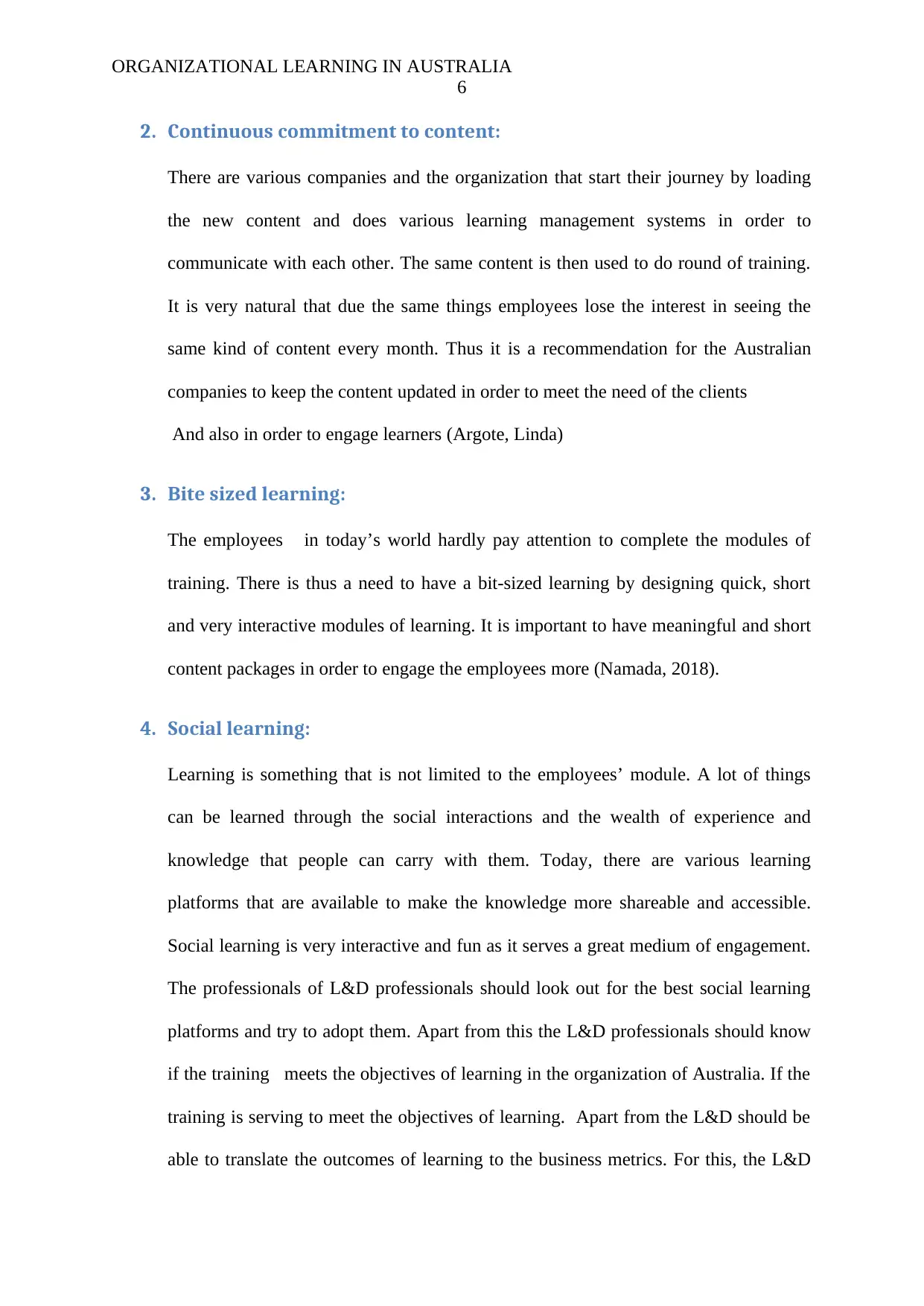
ORGANIZATIONAL LEARNING IN AUSTRALIA
6
2. Continuous commitment to content:
There are various companies and the organization that start their journey by loading
the new content and does various learning management systems in order to
communicate with each other. The same content is then used to do round of training.
It is very natural that due the same things employees lose the interest in seeing the
same kind of content every month. Thus it is a recommendation for the Australian
companies to keep the content updated in order to meet the need of the clients
And also in order to engage learners (Argote, Linda)
3. Bite sized learning:
The employees in today’s world hardly pay attention to complete the modules of
training. There is thus a need to have a bit-sized learning by designing quick, short
and very interactive modules of learning. It is important to have meaningful and short
content packages in order to engage the employees more (Namada, 2018).
4. Social learning:
Learning is something that is not limited to the employees’ module. A lot of things
can be learned through the social interactions and the wealth of experience and
knowledge that people can carry with them. Today, there are various learning
platforms that are available to make the knowledge more shareable and accessible.
Social learning is very interactive and fun as it serves a great medium of engagement.
The professionals of L&D professionals should look out for the best social learning
platforms and try to adopt them. Apart from this the L&D professionals should know
if the training meets the objectives of learning in the organization of Australia. If the
training is serving to meet the objectives of learning. Apart from the L&D should be
able to translate the outcomes of learning to the business metrics. For this, the L&D
6
2. Continuous commitment to content:
There are various companies and the organization that start their journey by loading
the new content and does various learning management systems in order to
communicate with each other. The same content is then used to do round of training.
It is very natural that due the same things employees lose the interest in seeing the
same kind of content every month. Thus it is a recommendation for the Australian
companies to keep the content updated in order to meet the need of the clients
And also in order to engage learners (Argote, Linda)
3. Bite sized learning:
The employees in today’s world hardly pay attention to complete the modules of
training. There is thus a need to have a bit-sized learning by designing quick, short
and very interactive modules of learning. It is important to have meaningful and short
content packages in order to engage the employees more (Namada, 2018).
4. Social learning:
Learning is something that is not limited to the employees’ module. A lot of things
can be learned through the social interactions and the wealth of experience and
knowledge that people can carry with them. Today, there are various learning
platforms that are available to make the knowledge more shareable and accessible.
Social learning is very interactive and fun as it serves a great medium of engagement.
The professionals of L&D professionals should look out for the best social learning
platforms and try to adopt them. Apart from this the L&D professionals should know
if the training meets the objectives of learning in the organization of Australia. If the
training is serving to meet the objectives of learning. Apart from the L&D should be
able to translate the outcomes of learning to the business metrics. For this, the L&D
Paraphrase This Document
Need a fresh take? Get an instant paraphrase of this document with our AI Paraphraser
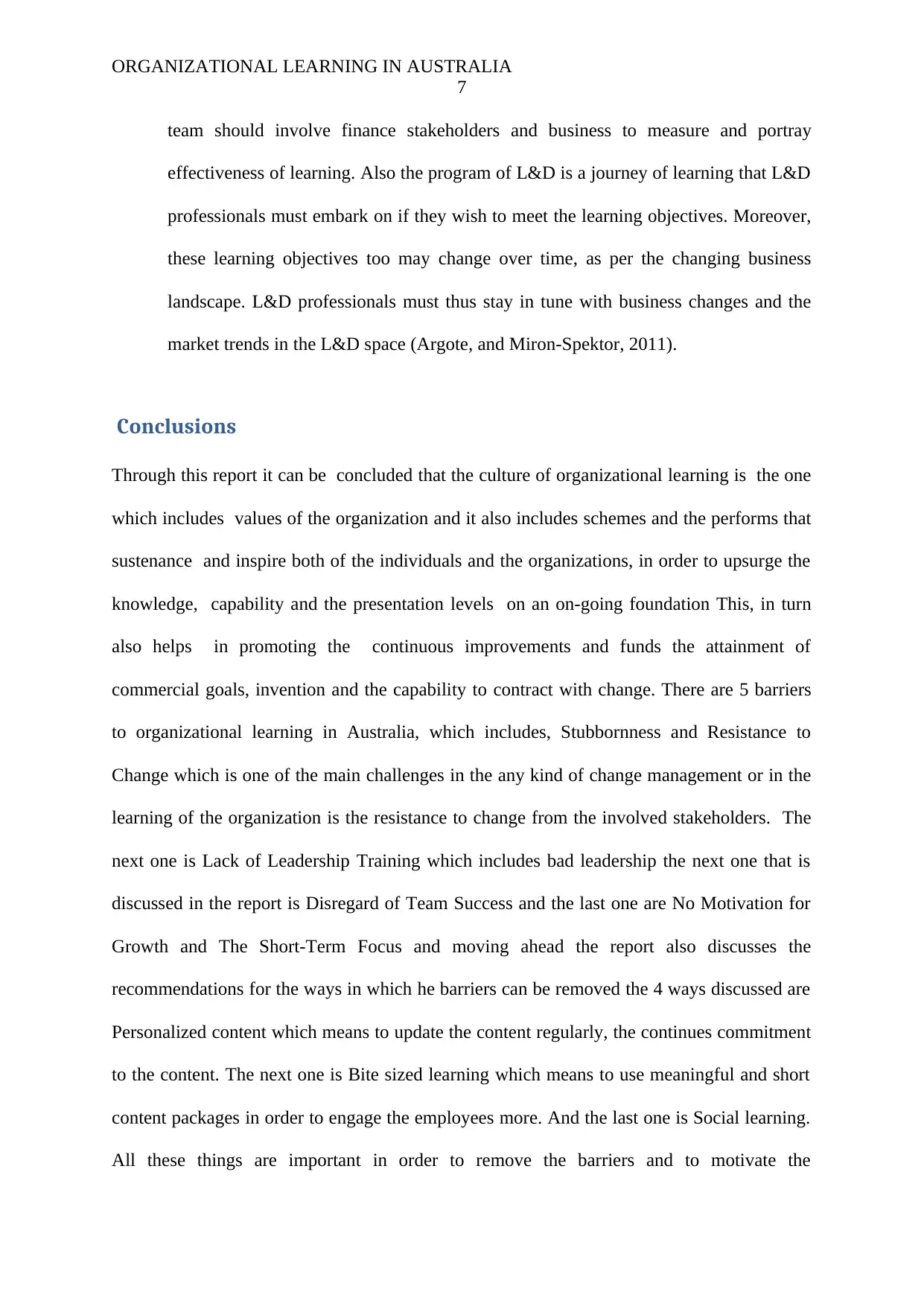
ORGANIZATIONAL LEARNING IN AUSTRALIA
7
team should involve finance stakeholders and business to measure and portray
effectiveness of learning. Also the program of L&D is a journey of learning that L&D
professionals must embark on if they wish to meet the learning objectives. Moreover,
these learning objectives too may change over time, as per the changing business
landscape. L&D professionals must thus stay in tune with business changes and the
market trends in the L&D space (Argote, and Miron-Spektor, 2011).
Conclusions
Through this report it can be concluded that the culture of organizational learning is the one
which includes values of the organization and it also includes schemes and the performs that
sustenance and inspire both of the individuals and the organizations, in order to upsurge the
knowledge, capability and the presentation levels on an on-going foundation This, in turn
also helps in promoting the continuous improvements and funds the attainment of
commercial goals, invention and the capability to contract with change. There are 5 barriers
to organizational learning in Australia, which includes, Stubbornness and Resistance to
Change which is one of the main challenges in the any kind of change management or in the
learning of the organization is the resistance to change from the involved stakeholders. The
next one is Lack of Leadership Training which includes bad leadership the next one that is
discussed in the report is Disregard of Team Success and the last one are No Motivation for
Growth and The Short-Term Focus and moving ahead the report also discusses the
recommendations for the ways in which he barriers can be removed the 4 ways discussed are
Personalized content which means to update the content regularly, the continues commitment
to the content. The next one is Bite sized learning which means to use meaningful and short
content packages in order to engage the employees more. And the last one is Social learning.
All these things are important in order to remove the barriers and to motivate the
7
team should involve finance stakeholders and business to measure and portray
effectiveness of learning. Also the program of L&D is a journey of learning that L&D
professionals must embark on if they wish to meet the learning objectives. Moreover,
these learning objectives too may change over time, as per the changing business
landscape. L&D professionals must thus stay in tune with business changes and the
market trends in the L&D space (Argote, and Miron-Spektor, 2011).
Conclusions
Through this report it can be concluded that the culture of organizational learning is the one
which includes values of the organization and it also includes schemes and the performs that
sustenance and inspire both of the individuals and the organizations, in order to upsurge the
knowledge, capability and the presentation levels on an on-going foundation This, in turn
also helps in promoting the continuous improvements and funds the attainment of
commercial goals, invention and the capability to contract with change. There are 5 barriers
to organizational learning in Australia, which includes, Stubbornness and Resistance to
Change which is one of the main challenges in the any kind of change management or in the
learning of the organization is the resistance to change from the involved stakeholders. The
next one is Lack of Leadership Training which includes bad leadership the next one that is
discussed in the report is Disregard of Team Success and the last one are No Motivation for
Growth and The Short-Term Focus and moving ahead the report also discusses the
recommendations for the ways in which he barriers can be removed the 4 ways discussed are
Personalized content which means to update the content regularly, the continues commitment
to the content. The next one is Bite sized learning which means to use meaningful and short
content packages in order to engage the employees more. And the last one is Social learning.
All these things are important in order to remove the barriers and to motivate the
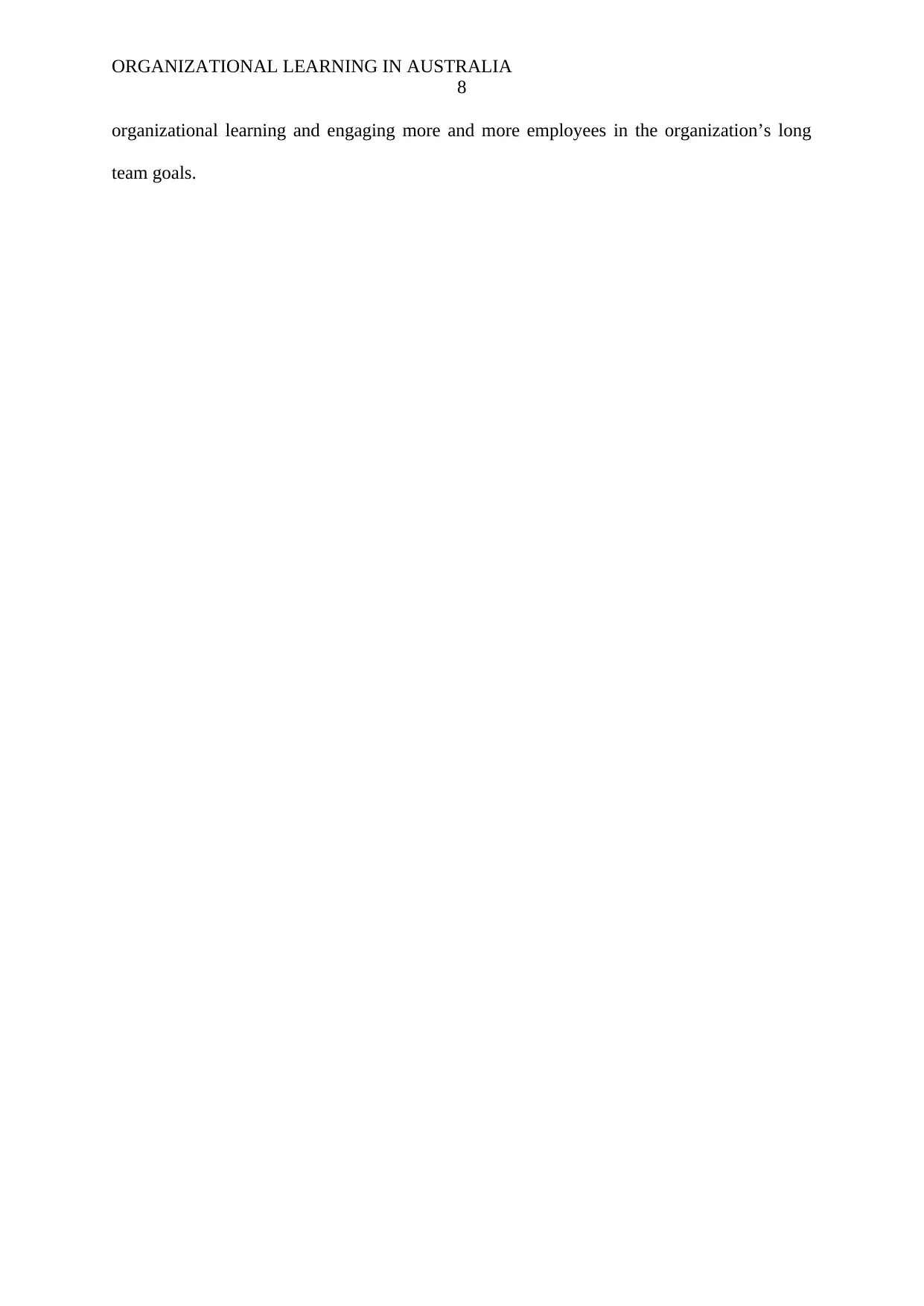
ORGANIZATIONAL LEARNING IN AUSTRALIA
8
organizational learning and engaging more and more employees in the organization’s long
team goals.
8
organizational learning and engaging more and more employees in the organization’s long
team goals.
⊘ This is a preview!⊘
Do you want full access?
Subscribe today to unlock all pages.

Trusted by 1+ million students worldwide
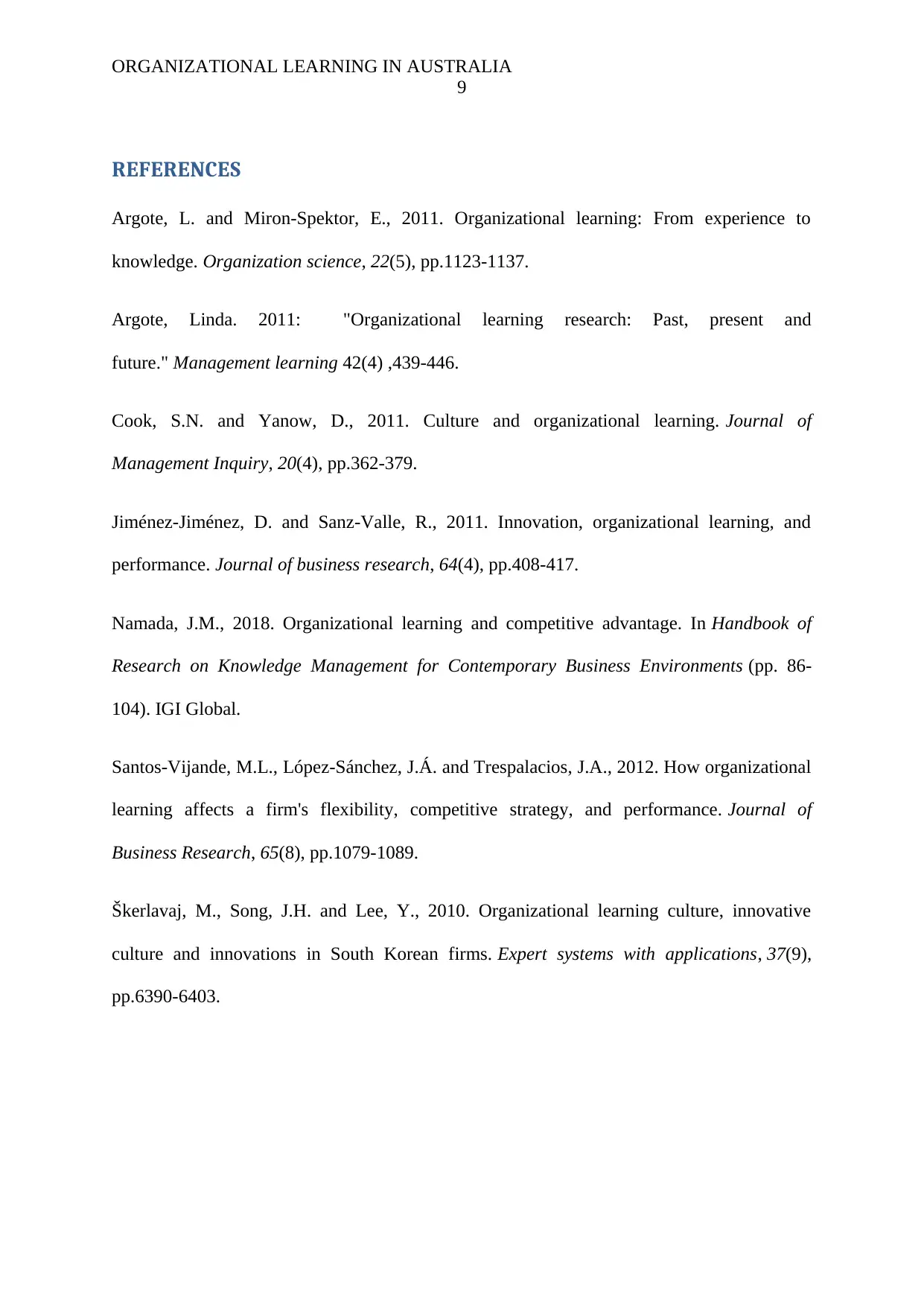
ORGANIZATIONAL LEARNING IN AUSTRALIA
9
REFERENCES
Argote, L. and Miron-Spektor, E., 2011. Organizational learning: From experience to
knowledge. Organization science, 22(5), pp.1123-1137.
Argote, Linda. 2011: "Organizational learning research: Past, present and
future." Management learning 42(4) ,439-446.
Cook, S.N. and Yanow, D., 2011. Culture and organizational learning. Journal of
Management Inquiry, 20(4), pp.362-379.
Jiménez-Jiménez, D. and Sanz-Valle, R., 2011. Innovation, organizational learning, and
performance. Journal of business research, 64(4), pp.408-417.
Namada, J.M., 2018. Organizational learning and competitive advantage. In Handbook of
Research on Knowledge Management for Contemporary Business Environments (pp. 86-
104). IGI Global.
Santos-Vijande, M.L., López-Sánchez, J.Á. and Trespalacios, J.A., 2012. How organizational
learning affects a firm's flexibility, competitive strategy, and performance. Journal of
Business Research, 65(8), pp.1079-1089.
Škerlavaj, M., Song, J.H. and Lee, Y., 2010. Organizational learning culture, innovative
culture and innovations in South Korean firms. Expert systems with applications, 37(9),
pp.6390-6403.
9
REFERENCES
Argote, L. and Miron-Spektor, E., 2011. Organizational learning: From experience to
knowledge. Organization science, 22(5), pp.1123-1137.
Argote, Linda. 2011: "Organizational learning research: Past, present and
future." Management learning 42(4) ,439-446.
Cook, S.N. and Yanow, D., 2011. Culture and organizational learning. Journal of
Management Inquiry, 20(4), pp.362-379.
Jiménez-Jiménez, D. and Sanz-Valle, R., 2011. Innovation, organizational learning, and
performance. Journal of business research, 64(4), pp.408-417.
Namada, J.M., 2018. Organizational learning and competitive advantage. In Handbook of
Research on Knowledge Management for Contemporary Business Environments (pp. 86-
104). IGI Global.
Santos-Vijande, M.L., López-Sánchez, J.Á. and Trespalacios, J.A., 2012. How organizational
learning affects a firm's flexibility, competitive strategy, and performance. Journal of
Business Research, 65(8), pp.1079-1089.
Škerlavaj, M., Song, J.H. and Lee, Y., 2010. Organizational learning culture, innovative
culture and innovations in South Korean firms. Expert systems with applications, 37(9),
pp.6390-6403.
1 out of 10
Related Documents
Your All-in-One AI-Powered Toolkit for Academic Success.
+13062052269
info@desklib.com
Available 24*7 on WhatsApp / Email
![[object Object]](/_next/static/media/star-bottom.7253800d.svg)
Unlock your academic potential
Copyright © 2020–2025 A2Z Services. All Rights Reserved. Developed and managed by ZUCOL.





